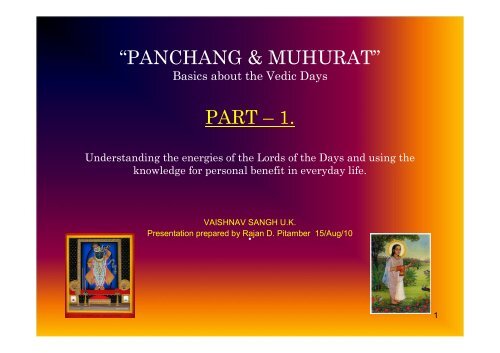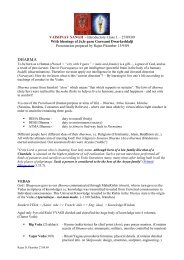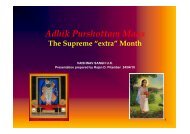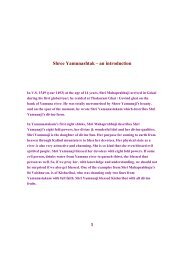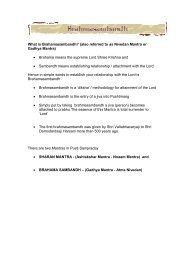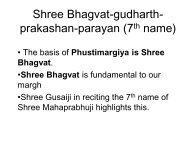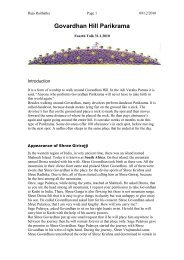“PANCHANG & MUHURAT” PART – 1. . - VaishnavSangh.org.uk
“PANCHANG & MUHURAT” PART – 1. . - VaishnavSangh.org.uk
“PANCHANG & MUHURAT” PART – 1. . - VaishnavSangh.org.uk
Create successful ePaper yourself
Turn your PDF publications into a flip-book with our unique Google optimized e-Paper software.
<strong>“PANCHANG</strong> & <strong>MUHURAT”</strong>Basics about the Vedic Days<strong>PART</strong> <strong>–</strong> <strong>1.</strong>Understanding the energies of the Lords of the Days and using theknowledge for personal benefit in everyday life.VAISHNAV SANGH U.K.Presentation prepared by Rajan.D. Pitamber 15/Aug/101
PANCHANG & MUHURATSYNOPSIS: theme of talk and basic points to be covered:----------------------------------------------------------------------------------•What are the Vaishnava scriptural references about TIME?•What is TIME astronomically and why important astrologically?•How ancient rishis perceived time and what they concluded?•Quality versus Quantity and conception of Muhurat by Vedic sages?•Relevance of Muhurat and understanding its benefits for mundane life?•CHOGADHIA system of Muhurat in daily practice.•PANCHANG - The 5 "limbs of time" given in Vedic scriptures.•The 1 st limb being Day of the Week <strong>–</strong> The 2 nd limb being the TithiWe shall explore in detail these most commonly known components of Panchang, yet littleunderstood!•What secrets do Puraanic scriptures reveal about the origins of Vaars, who are actuallyeternal deities governing different aspects of our everyday existence on this earthly plain?•How can we structure and schedule our daily life appropriately to be in tune with ourKarmic destiny and reap maximum benefit?•Finally…. why should we all bother to learn about this mysterious knowledge? Isn't seva, jaapa or meditationenough?!Vedas say that with knowledge of Time (“panchang”)the person becomes free from all sins and gains moksha2
Introduction <strong>–</strong> references from scripturesThe Supreme Lord said: "Time I am, the great destroyer of the worlds engaged here in destroyingall people, except for you [brothers] only, will all the soldiers who are situated on both sides,find their end.” (Bhagavad Gîtâ 1<strong>1.</strong>32)• Purânas - stories that have been told to make the philosophy of yoga and self-realizationaccessible and pleasant. Lord Krishna is the one who said "I am the time" three times in theBhagavad Gîtâ. Thus relating to time is relating to Him.__________________________________________• We know from the Vedic scriptures the superhuman controlling power to be the TIME. God is inthe beyond, or right in front of us, just the messenger of or chastiser for the morality of keeping thesoul in rhythm with Time.• In keeping respect with the Time of the Lord we automatically keep respect for Him and win Hisgrace (kripa), because He clearly identifies Himself with that Time. <strong>–</strong> KAAL PURUSH3
Introduction: TIME <strong>–</strong> references from scripturesShreemad Bhagvat <strong>1.</strong>8: 4• Lord Krishna together with the munis there pacified the shocked and affected family who had losttheir friends and family members, by showing how each is subject to the Time that cannot beavoidedS.B. <strong>1.</strong>13:17-20• Insurmountable, imperceptible eternal time supremely surpasses all those who are mad andengrossed in their thoughts of attachment to family affairs. Vidura, knowing this well, said toDhritarâshthra: 'O king, please withdraw yourself from here without delay, just see how fear hastaken over. In this material world there is no remedy of any measure or anyone as that fearconcerns the Supreme Lord of eternal time who arrives for all of us. When a person has to giveup life dear as it is to everyone, because it is certainly overtaken by the pull of this time - thenwhat to think of the other things he has acquired?S.B. <strong>1.</strong>13:46• How can this body and mind made up of the five elements [fire, water, air, earth and ether] that isunder the control of time, action and the material modes of nature [kâla, karma and gunas]protect others when it is as well bitten by that snake as all others?S.B. 6.1: 42• The divinity of the sun, the fire, the sky, the air, the gods, the moon, the evening, the day and thenight, the directions, the water and the land; all these are Dharma personified verily thus bearingwitness to the embodied living entity.S.B. 6.1; 47• Just as the present time is evidence of the past and an indication for the future, is even so thisbirth indicative of the dharma and adharma of ones past and future births.4
Introduction: TIME <strong>–</strong> references from scripturesBhagvat Gita. 17: 22• That charity which is given at the wrong place, the wrong time and to unworthy persons and as wellis given without respect and proper attention - that is said to be in the mode of ignorance.S.B. 2.5:11• From the light of the radiating world [called brahmajyoti] I do manifest just like the sun and the fire, aswell as the moon as also the firmament with its planets among the stars.S.B. 3.6:15• As His eyes, the sun, the local ruler of light entered the gigantic of which to the forms the experienceof the part of the eyesight came into being.S.B. 3.6:24• Also the heart of the Universal Being Chandra manifested, the rule of the moon, that entered as thecontrolling power over the mental activity by which the living entity decides and transacts.S.B. 3.7:33• How are the periodical offerings of respect regulated, o brahmin, to the created of the forefathers andhow are the time durations determined to the planets, the stars and luminaries?S.B. 3.11: 11-13• The aggregate of such a 'day' and 'night' is called an ancestral [traditional and solar] month with twoof them forming a season of which there are six [resp. 'cold' or hentanta, 'dew' or shirshira, 'spring' orvasanta, 'warm' or grishma, 'rainy' or varsha and 'autumn' or sarad, counted from the 22 of dec.]according the movement of the sun going through the southern and the northern sky• This movement of the sun is said to form one day of the demigods and is called a vatsara [a tropicalyear] of twelve months. The duration of life of the human being is estimated to be of a great many ofthose years [see also table]. The planets, the heavenly bodies [like the moon] and the stars all rotatealong with the atoms in the universe completing their orbits as a conclusion of years in the Almighty[or cyclic] of the eternal of time.5
Introduction: TIME <strong>–</strong> references from scriptures• Other types of time-respect do not carry His grace according to the Purâna that states thatdeceitful religiousness with an ulterior motive is rejected by the Vedic scripture. Thus the scriptureof Knowledge, the Bhagavad Gîtâ explicitly states that such worship of 'other gods' - read: formsof time-respect - is though confirmed as a form of devotion, is simply wrong (B.G. 9.23).• The respect of Time must be according His nature, in fact your own nature shared with Him, orelse one runs into danger of being alienated (B.G. 3.35). From this we may conclude that theeffort to control the time, outside of His will, outside of the nature of our own planet andposition in the sky, is a fundamental source of discord.• The Gîtâ (18.66) on top of that confirms this negative attitude in saying: 'abandon all forms ofreligion (and other association) and surrender to Me only'. Any human accord of time not intune with His nature is thus, fundamentally seen, as nothing but an obstruction.• Only He and what is His, the divine ordinance and the person thereof, is vedically to beconsidered correct.• Since He identifies with the natural manifestation of time (see again time-quotes) the truth ofreligion is thus a scientific affair. He is also thus the original scientist of the scientists. In simplelanguage: the TIME of Nature is a very powerful and mystical phenomenon.6
Introduction: to nature of TIME• What is Time? What is a month? day? hour?.... How ancient rishis perceived time and what theyconcluded?• TIME => Quantity vs. Quality ~ Science vs. Rishis• VAAR => Turn, rotation, go round• AHORATRA => Day and night = Hora >>Divya+Ratri• Take the English word "hour". Phonetically it should be pronounced "h o u r" ("h" being not silent)or "h o a r". At one time the word indeed must have been pronounced "hoar". "Hora-sastra" is thename of a science in Sanskrit, "hora" being from "ahoratram" (day and night). "Hora" is two andhalf nadikas or one hour. The English "hour" is clearly from this word. In the same way "heart" isfrom "hrd". There are so many words like this which could be traced to Sanskrit. It must havetaken a long time for words in other languages to evolve into their present form !!• ASTRONOMICAL/Mathematical concept of time is self-evident. An hour consists of a certainnumber of minutes, a day of hours and a year of days. But we rarely think about the fundamentalnature of time.• Time is passing non-stop, and we follow it with clocks and calendars. Yet we cannot study it with amicroscope or experiment with it. And it still keeps passing. We just cannot say what exactlyhappens when time passes?• Time is represented through change, such as the circular motion of the moon around the earth.7
Introduction: to nature of TIME• According to the general Theory of Relativity, space, or the universe, emerged in the Big Bangsome 13.7 billion years ago. Before that, all matter was packed into an extremely tiny dot (Bindu).That dot also contained the matter that later came to be the sun, the earth and the moon <strong>–</strong> theheavenly bodies that tell us about the passing of time. Before the Big Bang, there was no space ortime? … as we know it.• “In the theory of relativity, the concept of time begins with the Big Bang the same way as parallelsof latitude begin at the North Pole. You cannot go further north than the North Pole,” says KariEnqvist, Professor of Cosmology.• One of the most peculiar qualities of time is the fact that it is measured by motion and italso becomes evident through motion.8
Jyotisha and nature of TIMETIME <strong>–</strong> Quality vs. Quantity• JYOTI is Light and ISHA is Ishwaror God. Lord of Light or Science ofLight is Jyotisha.• Jyotisha is the science of all sciences.It is the Science of Time, Space andCausality.• Everything occurs in time and spacedue to some reason. A child is born ata particular place at a particular timedue to some reason.• Time and space are interconnectedThere is no Time without Space andno Space without Time.• The first breath is the beginning of thelife span. The interval between thesetwo points of time is called Life.Experience is Life.• Life is a continuity of experiencesrecorded in the life span.• The "experience" is in life. The lifespan is called longevity. Experiencewhether good or bad is between twopoints of time i.e. birth and death.• Time and Space is also beyond thecapacity of imagination of the mind.This is called "Anantham" (Infinity) i.e.without beginning or end.9
Jyotisha and nature of TIMEAncient sages saw a relationship between movement of planets and happenings inthe lives of human beings.• Time moves on. It is a relentless march. The beautiful dawn heats itself to becomenoon and then wanes away to be mellow dusk. The night dies to be born a fresh day.Time marches on steadily, softly and relentlessly.• Man sees his future becoming the present and his present rolling into an endlessabyss of the past. The present is forever contemplating plans and carrying outendless manoeuvers to brighten the future. It is here that Jyotisha [Panchang &Muhurat] steps in it prepares one to match steps with the strides of time.• Jyotisha is a harmoniser interfacing between a person and his destiny. It is the onethat can spot the "Golden Deer" of Lust and Greed and save the abduction of Sita likewisdom.• This fascinating "Vedanga" explains that "Bharata" is "Karmabhoomi" made strong,"adhyatmic" and imperishable by our Sages, Rishis and Gurus doing "Tapas", Japasand Teerthas.10
Jyotisha, Time and PanchangLimbs of Vedas - There are 6 limbs of Vedas of which astrology is the most importantand considered to be the eyes of Vedas. These limbs are in themselves independentsciences and very voluminous.<strong>1.</strong> CHANDAS <strong>–</strong> the legs of Vedas: meter, pada, syllables.2. VYAKARANA - the face: grammar3. KALPA - the hands: rituals, ceremonial customs.4. JYOTISHA - the eyes astrology.5. SHIKSHA - the nose: pronunciation, phonetics.6. NIRUKTA - the ears. Etymology, derivatives, history of words.Ancient measurements of TIME given by Rishis:• Paramanu is the smallest unit of time. Two Paramanus constitute one anu .• 3 Anu's = 1 Thrasarenu; 3 Thrasarenu's = 1 Thrudi; 100 Thrudi's = 1 Talpara; 30Talpara's = 1 Nimesha; 3 Nimesha's = 1 Kshana; 6 Kshana's = 1 Kashta(3.2 sec);15 Kashtas = 1 Laghu; 15 Laghu's = 1 Ghadi(24 minutes); 2 Ghadi's = 1 Muhurta;7.5 Ghadi's = 1 Yama(Prahara); 4 Yama's = 1 Day time(12 hours); 8 Yama's = 1Ahoratra(24 Hours); 15 Ahoratra's = 1 Paksha; 2 Paksha's = 1 Month; 2 Month = 1Ritu; 6 Months = 1 Ayana; 2 Ayana = 1 Samvatsara(1 Year);11
Jyotisha, Time and Panchang• 1 Samvatsara = 1 Deva Dina; 360 Devadina = 1 Devavarsha; 12,000 Devavarsha = 1Chaturyuga; 1000 Chaturyuga = 1 Kalpa; 2 Kalpa = 1 Bramha Dina = 14 Manvantaras; 1Manvantaras = 71 Chaturyuga; 2*30*12*120Kalpa's = 1 Bramha's life time;• 1200 Devavarsha(4,32,000 ManushyaVarsha's) = Kaliyuga; 2400 Devavarsha(8,64,000Manushyavarsh's) = Dwaparayuga; 3600 Devavarsha(12,96,000 Manushyavarsha's) = 1Tretayuga; 4800 Devavrsha(17,28,000 Manushyavarsha's) = Kritayuga;• 12,000 Devavarsha = 1 Mahayuga; 1000 mahayuga = 1 Day time of Bramha(this is called aKalpa); 100Bramha Varsha(Para) = 36,000 Bramha Dina's = 1 Mahakalpa(Mahapralayam);• There are time periods which are particularly effective and there are those which aredisadvantageous.• Ancient sages saw a relationship between movement of planets and happenings inthe lives of human beings12
Jyotisha, Time and PanchangPanchang/Muhurat <strong>–</strong> IMPORTANCE OF TIMING• Whether it's in the telling of a joke or striking a business deal, there's nothing more important thantiming. What you do is important but when you do it is just as important. Even little kidsunderstand the importance of timing. When they want their next cool toy, they catch their dads in agood mood and butter them up!• Ancient sages saw a relationship between movement of planets and happenings in thelives of human beings. There are time periods which are particularly effective and there arethose which are disadvantageous.• Each day of the week reflects the characteristics of the Lord who rules the day. Thus each dayhas its own speciality. By knowing these specialities we can structure our daily scheduleappropriately for maximum effect.• Just as timing is important in the material world, it's important in Spirituality too. The efficacy ofone's spiritual practices can be increased greatly by timing it according to rules. One who wants totranscend time must know the connection between timing and karma completely.• Panchang <strong>–</strong> 5 limbs of the Hindu calendar, for measurement of time. Vedas say that withknowledge of Panchang the person becomes free from all sins:<strong>1.</strong> Vara - prolongs life -strength, agni tattva2. Tithi - brings prosperity, wealth -fulfilment of desires, jala3. Karana - success in all actions -accomplishment, prithvi4. Nakshatra- removes sins -disposition of mind, mana, vayu5. Yoga - immunity from diseases -co-operation, sambandha13
Muhurat, Time and PanchangPanchang/Muhurat <strong>–</strong> IMPORTANCE OF TIMING• Within any given day, there are certain time periods which are particularly spiritually potent. Wewill mention three such time periods in every day:• Brahma Muhoortham: the three hour time period culminating at dawn; assuming a 6 a.m.sunrise, this would be between 3 a.m. and 6 a.m. everyday.• Abhijit Muhoortham: high noon when the sun is at its zenith; assuming a 6 a.m. sunrise, thiswould be at 12 noon <strong>–</strong> 2pm. It is Sri Hari Vishnu's time. When you don't have any muhurthamyou can use this time if its not overlapped by any adverse chogadhia, etc..• Nitya Pradosha Kaalam: one and a half hours before dusk and half an hour thereafter; assuminga 6 p.m. sunset, this would be between 4:30 p.m. and 6:30 p.m. everyday.• These times are also known as sandhi kaalam, junction times within a day. The first is when thenight meets the day, the second is when morning meets afternoon and the third is when daymeets night. The Rishis say that spiritual activities conducted during these time periods areparticularly effective. Spiritual aspirants should make use of these potent time periods for rapidspiritual advancement.• Within any given day, there are also certain time periods which are inauspicious (for mundaneactivities). Two of these are Raahu Kaalam and Yama Gandam. The Rishis say that it's ideal ifwe can use these times totally for worship. If these time periods are used for worship and not formaterial activities, they yield manifold spiritual benefits14
Panchang/Muhurat <strong>–</strong> IMPORTANCE OF TIMINGMuhurat or Muhurta• Muhurta is essentially (1) a measure of time equal to 48 minutes and also (2) refers to theapplication of Vedic astrology wisdom in determining the auspicious time for starting an event.• Since we know that the future of an enterprise can be safely predicted using its birth time, then itwould be a wise decision to choose an auspicious time for its inception.• Muhurta is a time measure of 48 minutes reckoned from sunrise as a part of definition of lineartime concepts (based on the speed of light as in the Rig Veda <strong>1.</strong>50).• There are 30 muhurtas in a nakshatra ahoratra (sidereal day and night reckoned fromone sunrise to the next sunrise). = 24 Hours• The period from sunrise to noon is divided into 7½ Muhurta as is the period betweennoon and sunset. In a similar manner the period from sunset to midnight and midnightto the next sunrise is divided into 7½ Muhurta each (7½ Muhurta x 4 = 30 muhurta).• These 4 points of time - Sunrise, Noon, Sunset and Midnight are the 4 Gayatri padas.Spiritually potent and auspicious periods for prayers, japa, seva, puja etc..15
CHOGHADIA MUHURATCHOGADHIA:• Disha shool in vastu shastra forbids travel in certain directions on certain days.• **Eastward travel on a Saturday is ill-omened. **And if you are headed Northwards, don’tgo on a Tuesday.• India’s Marwaris and Gujaratis have great faith in astrology and vastu shastra and they benefitfrom it. They always choose an astrologically propitious time to take business decisions, whetherit’s to start a factory or make an investment. So much so that they are great respecters ofChogadhia, a Hindu belief, which divides a day into 7 equal parts: three are good, two are so-so,and three are bad. The good parts are shubh, laabh, and amrit, which means auspicious, profit,and elixir. The so-so ones are chanchal or chara, which means erratic. The three bad timeperiodsare rog (illness), udveg (tension), and kaal (disaster).• Traditionally chogadia is used only for travel muhurthas but due to simplicity it is used widely forany muhurtha• People may consider disha shool hocus-pocus, but Marwari businessmen have travelled for manycenturies according to disha shool. When GD Birla first went to Calcutta to make his fortune, hisfamily got a learned sadhu to decide on a right day for his eastward journey.16
CHOGHADIA & MUHURATCHOGADHIA:• The word ghadi means "time". During the Ancient times in India, day and night were measured inghadi instead of hours or minutes.• From this ghadi, the time showing device evolved into what is known as a watch, a portablemechanical timepiece.• In the Indian language, a watch is also called ghadi or ghadiyal.• The ghadi is equal to exactly 22.5 minutes (approx. 24 min), while the word cho means "four."• There are many like words beginning with "cho" (four), such as chokhunn (four corners), chogath(four knotted), chogatho (fourfold), chogannu (four times), chogam (four directions), chogdarm (allsides), chogan (all around), etc.• Similarly, "chogadiyu’n" means "four ghadis." The beating of four drums at every fourth ghadi alsomeans choghadia.• It clearly suggests that the term chogadiyu’n or chogadia embodies a dual significance: onone hand, it means four ghadis; on the other hand, it means four drums.• Under this computation, the term "choghadiyu’n" represents duration of 90 minutes.• Water Clocks were regulated to measure the time and ghadiyal or gong to announce the hour tothe people in principal towns.• Generally, a day is also divided into 8 parts, each part contains 1 hour and 30 minutes. The firstpart starting with the sunrise on that day, and last part ending on sunset on that day approximatelyfor the day times.17
CHOGHADIA & MUHURATCHOGADHIA:• Similarly, there are 8 parts starting with sunset of current day and ending at sunrise next day.• There are 7 types of time periods of which 4 are considered auspicious:- amrit (nectar),- shubh (luckiest),- labh (benefit)- Char or Chanchal (unstable <strong>–</strong> so so period, not bad)• and 3 are inauspicious, viz.- rog (disease),- kaal (death)- and udvegh (fear).• These seven kinds of time periods are also known as chogadiyu’n in the Indian society, or theseven moments in a day.• These good and bad moments were associated with each day, such as Monday (amrit), Tuesday(udvegh), Wednesday (rog), Thursday (shubh), Friday (labh), Saturday (kaal) and Sunday (char).• The astrologers say that works which are undertaken during auspicious moments generally havea positive result and those undertaken during inauspicious moments have a negative result.• Indians were firm in their conviction that everything in their mundane existence was determinedand controlled by the movement of the planets and stars.18
CHOGADHIA:CHOGHADIA & MUHURAT• During the tilaka or magni, that is, betrothal ceremony or a formal recognition when the partiesagreed to the wedding of the future bride and bridegroom. A grand mandapa (a tree-trunk studdedwith valuable stones and covered with green twigs, surrounded by pillars of sandal-wood andcovered with a roof) was constructed and a scarlet cloth was spread on the floor.• Wedding wreaths of flowers or festoons of mango leaves were hung before the door. The parentswould draw a square on the ground in front of the door, known as door worship (duar puja). Thesquare was also equally divided into 12 parts, indicative of the lunar months.• The drummers would sit at the four corners of the square and play the drums at the timepropounded by the astrologers.• The beat of drums was known as the chogadia. The moment was considered so propitious in thesociety that the people would start their new business, shift from old to new houses, proceed ontravel, preparing and taking medicines, sowing seeds, planting trees, taking and giving loans, etc.on that hour.• The special songs being chanted at the time of chogadiyu’n became known as "chogadia" in theIndian culture.• In ancient times, during the proclamation of the new kingdom, the singers and poets were invitedto sing songs to announce the new kingdom of the regions under the king’s sway. From thepalace or temple, a trumpet was blown at an interval of four ghadis during the day to glorify thenew kingdom.• The first sound was blown at dawn and the last at dusk. The singing of the songs or blowing of thetrumpet was also called the chogadia.• Sometimes, the drums (mrdangam) with ankle bells (gejai) were beaten at four corners of thepalace, known as char naqara or char dhol. 19
Chogadhia - exampleChogadia For 15 August, 2010 Harrow U.K.Start Time End Time Chogadia Details• 5:34:50 AM 7:16:17 AM Udveg InauspiciousChogadia• 7:16:17 AM 8:57:45 AM Chara AuspiciousChogadia• 8:57:45 AM 10:39:12 AM Laabh AuspiciousChogadia• 10:39:12 AM 12:20:39 AM Amrit AuspiciousChogadia• 12:20:39 PM 14:2:7 PM Kaal InauspiciousChogadia• 14:2:7 PM 15:43:35 PM Shubh AuspiciousChogadia• 15:43:35 PM 17:25:2 PM Rog InauspiciousChogadia• 17:25:2 PM 19:6:29 PM Udveg InauspiciousChogadia• 19:6:29 PM 20:25:2 PM Shubh AuspiciousChogadia• 20:25:2 PM 21:43:35 PM Amrit AuspiciousChogadia• 21:43:35 PM 23:2:7 PM Chara AuspiciousChogadia• 23:2:7 PM 24:20:39 PM Rog InauspiciousChogadia• 0:20:40 AM 1:39:12 AM Kaal InauspiciousChogadia• 1:39:12 AM 2:57:45 AM Laabh Auspicious20
Tithi <strong>–</strong> Lunar Days - Introduction• Humans, according to Sage Mahatapas the great ascetic, are born from the Hiranyagarbha, thecosmic womb in their different forms to the world we live in. They represent separate principles ofcreation, all being distinct yet the same.• Each person is connected to the Atma, the eternal soul that never dies. A portion of this eternalsoul comes through the Hiranyagarbha to earth in the form of the Jiva Atma, the living soul. Sun isatma and Moon is Jiva atma.• The daily distance between the Sun and Moon is a tithi.• The principles of divinity are the deities that rule the tithis. These are Agni, Ashwini Kumaras,Gauri, Ganapati, Nagas, Kartikeya, Aditya, Matrs, Durga, Diks, Kubera, Vishnu, Yama, Rudra,Chandra and Pitris.• Birth on the tithi will show what divine principle you are working with and how to deal with and getthe best out of it.• Tithis represent the different natures of human life if when properly understood give us theopportunity to preserve our precious amrita that the soul has gathered over its previous lifetimes.It shows our weaknesses, our strengths as well as the connections to the deities. Each tithi is apersonification of a deity and reflects how we face the law of karma and guard the soul.21
Tithi <strong>–</strong> Lunar Days - Introduction• Day Tithi Quality Deity• 1 Pratipada one giving rise Agni• 2 Dwitiya Auspicious Ashwini Kumar/ Brahma• 3 Tritiya strength and power Gauri/Parvati- wife of Shiva• 4 Chathurthi negative Ganapati• 5 Panchami Laxmi/wealth Naga• 6 Shashti Fame Kartika- Mangal• 7 Saptami Friendly Sun/Surya Narayan• 8 Ashtami Conflict Shiva/ Matrgana• 9 Navami Aggressive Durga• 10 Dashami Soft Yama- /Diks , goddesses of 10 directions• 11 Ekadashi Happiness Vishwedeva/ Kubera/ Vayu• 12 Dwadashi Fame Vishnu• 13 Trayodashi Victory Kamdeva/ Dharma• 14 Chaturdashi Aggressive Shiva/ Rudra/ Kali• 15/ Purnima Soft Soma• 30/ Amavasya inauspicious Pitris22
Tithi <strong>–</strong> Lunar Days*Bright Fortnight (Sh<strong>uk</strong>la Paksha) “sud”*Dark Fortnight (Krishna Paksha) “vad”• 1st. Pratipada (First Crescent)• 2nd. Dvitiya• 3rd. Tritiya• 4th. Chaturthi• 5th. Panchami• 6th. Shashthi• 7th. Saptami• 9th. Navami• 10th. Dashami• 11th. Ekadashi• 12th. Dvadashi• 13th. Trayodashi• 14th. Chaturdashi• 15th. PURNIMA (Full Moon)• 15th. AMAVASYA (New Moon)• Please remember that Indian date does notchange at midnight 0:00 hours. the day is fromone sunrise to another sunrise.• In vedic timekeeping, a tithi is a lunar day, orthe time it takes for the longitudinal anglebetween the moon and the sun to increase by12°. degrees• Tithis begin at varying times of day and vary indates the duration varies.• The second tithi is the next 12 degrees of theMoon away from the Sun, 12 to 24 degrees.• A particular day is ruled by the tithi at sunrise,but the tithi can change anytime of the day ornight as it is not based on the solar day.• Tithis vary in duration from approximately 19to 26 hours, according to the movement of theMoon.• Each tithi has a name, a ruling planet, and canbe used in muhurta (picking a proper time).23
Tithi <strong>–</strong> Lunar DaysBright Fortnight (Sh<strong>uk</strong>la Paksha) “sud”Dark Fortnight (Krishna Paksha) “vad”• 1st. Pratipada (First Crescent)• 2nd. Dvitiya• 3rd. Tritiya• 4th. Chaturthi• 5th. Panchami• 6th. Shashthi• 7th. Saptami• 9th. Navami• 10th. Dashami• 11th. Ekadashi• 12th. Dvadashi• 13th. Trayodashi• 14th. Chaturdashi• 15th. PURNIMA (Full Moon)• 15th. AMAVASYA (New Moon)• In the traditional Vedic calendar system the tithis areused as dates, so one's birthday would be on the sametithi as they were born, the relationship between theSun (Father) and Moon (Mother) would be the same onone's birthday as it was the day of birth. In this way, theGregorian dates have no astrological relevance.• The tithi is ruled by Jala Tattva (the waterelement/Venus) and shows the state of the mind;whether it is excited, bored, nervous, afraid,agitated or calm.• The tithi is used to see if an event will be successful. Italso shows whether people will cooperate with theproject or not.Planet Tithi TithiSun 1 9Moon 2 10Mars 3 11Mercury 4 12Jupiter 5 13Venus 6 14Saturn 7 15Rahu 8 024
Tithi <strong>–</strong> Lunar DaysBright Fortnight (Sh<strong>uk</strong>la Paksha) “sud”Dark Fortnight (Krishna Paksha) “vad”• 1st. Pratipada (First Crescent)• 2nd. Dvitiya• 3rd. Tritiya• 4th. Chaturthi• 5th. Panchami• 6th. Shashthi• 7th. Saptami• 9th. Navami• 10th. Dashami• 11th. Ekadashi• 12th. Dvadashi• 13th. Trayodashi• 14th. Chaturdashi• 15th. PURNIMA (Full Moon)• 15th. AMAVASYA (New Moon)• The rulership of the tithis is based on the days of theweek; Sunday (Sun) rules the 1st day, Monday (Moon)rules the 2nd , Tuesday (Mars) rules the 3rd tithi,Wednesday (Mercury) rules the 4th tithi, etc.• Fasting on EKADASHI will get one over anger,because Mars rules it. Vaishnavas fast on the 11thtithi to be perfect peaceful Vaishnavas. No one willfight with the one who has done this fast for sometime.• Fasting on Ashtami will make it so you never cheatanyone, so YOU will also not get cheated.• Fasting on the full Moon will give you truth as itremoves the negative effects of Saturn.Planet Tithi TithiSun 1 9Moon 2 10Mars 3 11Mercury 4 12Jupiter 5 13Venus 6 14Saturn 7 15Rahu 8 025
Tithi <strong>–</strong> Lunar Days• These fifteen tithis are also broken down into fivegroups given below:• Trittya tithi (3rd ) is ruled by Mars but as it isJaya (ruled by akash/Jupiter) so it will bringtwo people together, as akash is the bindingforce (that keeps the jiva in the body).• Ekadasi tithi (11th ) is ruled by Mars and it isNanda (ruled by fire-Mars) so the fighting is verystrong. Mars is passionate, energetic, and createsconflict, it is not good for marriage, though it isgood for war and leadership.• Nanda Tithi <strong>–</strong> Bestows happiness, enjoyment.• Bhadra Tithi - Auspicious for stating new work• Jaya Tithi - Auspicious for winning overenemies.• Rikta Tithi <strong>–</strong> To be avoided for any importantwork.Nanda Fire 1, 6, 11Bhadra Earth 2, 7, 12Jaya Akash 3, 8, 13Rikta Water 4, 9, 14Purna Vayu 5, 10, 15Planet Tithi TithiSun 1 9Moon 2 10Mars 3 11Mercury 4 12Jupiter 5 13Venus 6 14Saturn 7 15• Poorna Tithi <strong>–</strong> Auspicious to complete all jobs.Rahu 8 026
Tithi <strong>–</strong> Lunar Days• Nanda Tithi <strong>–</strong> Bestows happiness, enjoyment.• Bhadra Tithi - Auspicious for starting new work• Jaya Tithi - Auspicious for winning over enemies.• Rikta Tithi <strong>–</strong> To be avoided for any important work.• Poorna Tithi <strong>–</strong> Auspicious to complete all jobs.Specifics on Muhurta:When certain Tithis line up with specific Varas (days) theyare considered auspicious and therefore work on thosedays is accomplished successfully. If Pratipat (1st ),Shashti (6th ), or Ekadashi (11th ) fall on a Friday, it isconsidered auspicious.NANDA BHADRA JAYA RIKTA PURNA1st day 2nd day 3rd day 4th day 5th day6th day 7th day 8th day 9th day 10th day11th day 12th day 13th day 14th day 15th-30thFridayWednesdayTuesday Saturday Thursday• In the same way there are certain combinationsthat are inauspicious, where there will be hurdlesin accomplishing works. These inauspicious Dayshave been called Dagdha, Visha, and Hutashan.SUN. MON. TUE. WED. THUR. FRI. SAT.DAGDHA 12th 11th 5th 3rd 6th 8th 9thVISHA 4th 6th 7th 2nd 8th 9th 7thHUTASHAN12th 6th 7th 8th 9th 10th 11th• Vish Yoga and Hutashan yoga are inauspicious.The poisonous nature of vish yoga is reflected byits name. It destroys a native’s auspicious Karma.• People who are working on new projects shouldpay special attention to vish and hutashan yogas.New assignments and works should not becommenced on a day which has either of these.• Besides these, foundation of house or shop mustnot be laid during these malefic yogas.• Vish and hutashan yogas are inauspicious forjourneys as they may provide negative results.27
Tithi <strong>–</strong> Lunar Days - summaryTITHI TITHI - NAME NATURE OF RESULTS IN RELATION TO EVENTS1 1- PRATIPAT RELIGIOUS CEREMONIES, MARRIAGE, FESTIVALS AND RITUALS. TRAVEL IS FORBIDDEN.THE PERSON IS GOOD IN NATURE BUT LACKS ENJOYMENT. DO NOT MIX WITH THEWRONG PEOPLE ON THIS DAY. CONSTRUCTION IS NOT FAVORABLE. NATURE IS VRIDDHI(INCREASE) AND THE LORD IS AGNI (FIRE)2 2- DWITEEYA LAYING OF FOUNDATIONS FOR HOUSES IS FAVORABLE. PERMANENT NATURE. GIVESSUCCESS WHILE TRAVELING. THE PERSON WILL HAVE DUAL NATURE. OFTEN LACKSLOVE, AFFECTION AND FRIENDSHIPS. NOT CAPABLE OF UNDERSTANDING THE TRUTHNATURE IS AUSPICIOUS HAPPENINGS AND THE LORD IS BRAHMA (GOD OF CREATION)3 3-TRITEEYA HAIR CUT- AND PERSONAL BEAUTY CARE. GOOD HEALTH AND OTHER BENEFICIALRESULTS. MAY BE UNMOTIVATED AND LAZY, LACKING IN ACTION, CONFUSED ANDRESTLESS. CONSTRUCTIONS IS FAVORABLE. GIVES GOOD HEALTH & WEALTH ANDBENEFICIAL RESULTS. DIRECTION NORTH EAST. NATURE IS POWER GIVING AND THELORDS IS GAURI (GODDESS -WIFE OF SHIVA)4 4- CHATURTHI DESTRUCTION OF COMPETITORS AND OBSTRUCTIONS. ACTS OF COMBAT. MAY CAUSEFEAR OF DEATH WHILE TRAVELING. DIRECTION WEST. CONSTRUCTION IS NOTFAVORABLE. NATURE IS KHALA AND THE LORD IS GANESH (GOD OF FULFILLMENT)5 5- PANCHAMI TAKING MEDICATION, FOR THE FIRST TIME. GOOD QUALITIES, EDUCATION ANDWEALTHY. SURGERY. TRAVEL IN THIS TITHI GIVES ALL ROUND SUCCESS AND VICTORY.CONSTRUCTION IS FAVORABLE. NATURE IS LAXMI (WEALTH) AND THE LORDS ARENAGA (SERPENTS)6 6- SHASHTHI MAKING NEW FRIENDS, CORONATION, FESTIVITIES etc. LIKES TO WANDER AIMLESSLY.FAME and SPOT- LIGHT. BEING AGGRESSIVE AND DEBATES. TRAVELING IN THIS TITHIMAY CAUSE LOSSES. CONSTRUCTION WORK IN THIS TITHI GIVES MODERATE SUCCESS.NATURE IS FAME GIVING AND THE LORDS ARE KARTIKEYA (LORD OF VAL OUR)28
Tithi <strong>–</strong> Lunar Days - summaryTITHI TITHI - NAME NATURE OF RESULTS IN RELATION TO EVENTS7 7- SAPTAMI CONSTRUCTION AND PURCHASE - VEHICLES & TRAVELING IS AUSPICIOUS.KNOWLEDGE, STUDYING. FORTUNATE WITH CHILDREN AND WEALTH. GOOD AT SALES.DIRECTION SOUTH. CONSTRUCTION IN THIS TITHI GIVES FAVORABLE RESULTS. NATUREIS FRIENDLY AND THE LORDS ARE SURYA NARAYAN8 8- ASHTAMI GOOD TIME TO DEFEND YOURSELF. HEALTH AND HEALING. WILL PRODUCES MANYSOURCES OF MONEY for THE PERSON. RELIGIOUS AND SENSUAL SEEKERS. TRAVELINGIN THIS TITHI GIVES ILL-HEALTH. DIRECTION SOUTH EAST. CONSTRUCTION NOTFAVORABLE. NATURE IS CONFLICT AND THE LORD ARE SHIVA (LORD OF DESTRUCTION)9 9- NAVAMI REMOVING OBSTRUCTIONS AND COMPETITORS/ENEMIES. TRAVELING ON THIS TITHI ISNOT GOOD THE PERSON MAY NOT RETURN.. FOND OF GODS AND THEIR WORSHIP.CONSTRUCTION GIVES MODERATE RESULTS. NATURE IS AGGRESSION AND THE LORDSARE DURGA (GODDESS OF POWER)10 10- DASHAMI GOOD DEEDS, WORSHIP OF GODS OR HOLY PERSON. TRAVEL MAY GIVE GAINS - SALESOR PURCHASE OF LAND. WELL- LIKED PERSON AND HAPPY. HOMELY PERSON.DIRECTION NORTH WEST . GOOD POWER OF DISCRIMINATION BETWEEN RIGHT ANDWRONG. CONSTRUCTION IS FAVORABLE. NATURE IS SOBER AND THE LORDS ARE YAMA(GOD OF DEATH)11 11- EKADASHI FASTING AND WORSHIP OF VISHNU. AUSPICIOUS RESULTS FROM TRAVELING. IM<strong>PART</strong>SLEARNING AND GOOD FINANCIAL LUCK. INTELLIGENT AND PURE MINDED OFTENHONORED BY THE SOCIETY. DIRECTION NORTH. CONSTRUCTION NOT FAVORABLE.NATURE IS ENJOYMENTS AND THE LORDS ARE VISHVEDEVAH12 12- DWADASHI FIRE SACRIFICES. MAY CAUSE LOSE OF WEALTH IN TRAVELING. GIVES MODESTY ANDLEARNING. USUALLY RESTLESS AND LIKES TO WANDER. INCONSTANT, UNSTEADYMINDS. TRAVELING MAY CAUSE LOSS OF WEALTH. CONSTRUCTION IS -FAVORABLE----NATURE IS FAME & GOOD QUALITIES AND THE LORDS ARE VISHNU29
Tithi <strong>–</strong> Lunar Days - summaryTITHI TITHI - NAME NATURE OF RESULTS IN RELATION TO EVENTS13 13-TRAYODASHI MAKING FRIENDS, ENJOYMENT OF PLEASURES. IM<strong>PART</strong>S KINDNESS AND EDUCATION.HOSPITABLE, KIND AND CHARITABLE. TRAVEL ON TRAYODASI IS SUITED FORALLIANCES AND FRIENDSHIP. CONSTRUCTION WORK IS FAVORABLE. NATURE ISVICTORY AND THE LORDS ARE KAMADEVA (GOD OF LOVE)14 14-CHATURDASHI RELIGIOUS ACTIVITIES. BOLD AND DARING ACTIONS. MAY GET HONOUR FROM THESOCIETY . TRAVELING IS FORBIDDEN AS A RULE. DIRECTION EAST. CONSTRUCTIONWORK IS NOT FAVORABLE. NATURE IS AGGRESSION AND THE LORDS ARE SHIVA (GODOF DESTRUCTION), KALI.15 PURNIMA -15 FULLMOONRIGHTFUL ACTION, CEREMONIES AND HOUSEHOLD AFFAIRS- LUCK & VIRTUE. WEALTHYAND WISE AND BRIGHT AND HARDWORKING. VERY FOND OF FOOD, AND DEVELOPROMANTIC ATTRACTIONS . TRAVEL IS FORBIDDEN. NATURE IS SOBER AND THE LORDSARE CHANDRA DEVA.15 AMAVASYA -15 - NEWMOONPROPITIATION OF THE ANCESTORS. TRAVELING IS NOT GOOD. MENTALLY ANDPHYSICALLY MAY BE DISTURBED AND DECEPTIVE AND CRUEL. COURAGEOUSACTIVITIES. DIRECTION SOUTH WEST. CONSTRUCTION WORK IS NOT FAVORABLE. THISIS MAINLY FOR PITRIDEV (ANCESTORS).30
PANCHANG & MUHURATSYNOPSIS: theme of talk and basic points to be covered:•What are the Vaishnava scriptural references about TIME?•What is TIME astronomically and why important astrologically?•How ancient rishis perceived time and what they concluded?•Quality versus Quantity and conception of Muhurat by Vedic sages?•Relevance of Muhurat and understanding its benefits for mundane life?•CHOGADHIA system of Muhurat in daily practice.•PANCHANG - The 5 "limbs of time" given in Vedic scriptures.•The 1 st limb being Day of the Week <strong>–</strong> The 2 nd limb being the TithiWe shall explore in detail these most commonly known components of Panchang, yet little understood!•What secrets do Puraanic scriptures reveal about the origins of Vaars, who are actually eternal deities governingdifferent aspects of our everyday existence on this earthly plain?•How can we structure and schedule our daily life appropriately to be in tune with our Karmic destiny and reapmaximum benefit?Finally….…… why should we all bother to learn about this mysterious knowledge?Isn't seva, jaapa mantra or meditation enough?!Well the answer lies within ourselves <strong>–</strong> do we really sincerely want ONLY spiritual liberation,or do we hanker after material desires and pursuits, even a tiny bit??For the true Yogi and spiritual aspirant there is no need for anything! But when we are boundto Earthly life the rules are fixed (for all) whether we want them or not or whether we believe itor not.************************************************************************************31
Zodiac + Lunar Mansions32


